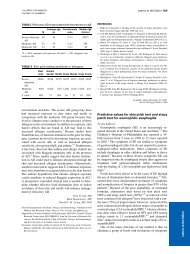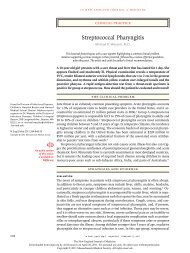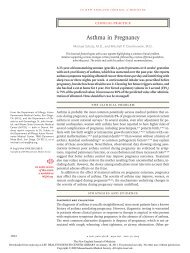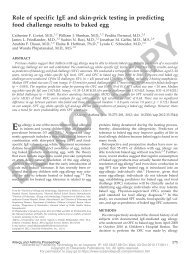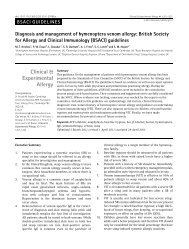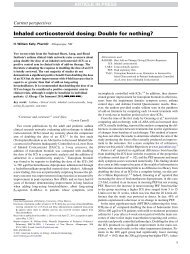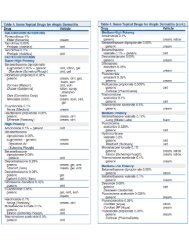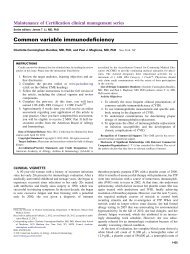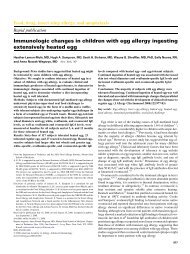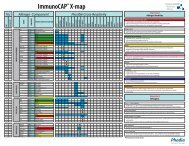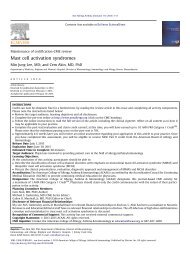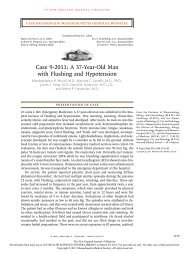Vasculitis - Langford.pdf - AInotes
Vasculitis - Langford.pdf - AInotes
Vasculitis - Langford.pdf - AInotes
Create successful ePaper yourself
Turn your PDF publications into a flip-book with our unique Google optimized e-Paper software.
<strong>Vasculitis</strong><br />
Carol A. <strong>Langford</strong>, MD, MHS<br />
Director, Center for <strong>Vasculitis</strong> Care and Research<br />
Department of Rheumatic and Immunologic Diseases<br />
Cleveland Clinic
Employment<br />
- None<br />
Financial Interests<br />
- None<br />
Research Interests<br />
- Study drug provided by: Genentech, Bristol-Myers Squibb<br />
Organizational Interests<br />
Gifts<br />
- None<br />
- None<br />
Other Interests<br />
- None<br />
CME Disclosure Statements<br />
Carol A. <strong>Langford</strong>, MD, MHS
CME Disclosure Statements<br />
Carol A. <strong>Langford</strong>, MD, MHS<br />
Unlabeled use of commercial products<br />
To date, there are no therapeutic agents specifically approved<br />
for the treatment of vasculitis<br />
All references to use of a commercial product discussed in<br />
this presentation constitute an unlabeled use of the product
<strong>Vasculitis</strong><br />
Why is vasculitis important to the allergist/immunologist <br />
• <strong>Vasculitis</strong> is an immunologically mediated process<br />
• Undiagnosed vasculitic disease may be referred for allergy consultation<br />
(sinus disease and asthma are seen in certain forms of vasculitis)<br />
• In some communities, vasculitis patients managed by allergists<br />
• Included in Board examinations
<strong>Vasculitis</strong> = Inflammation<br />
of the Blood Vessel<br />
inflammation<br />
blood vessel damage<br />
compromise of vessel lumen<br />
attenuation of vessel wall<br />
organ ischemia<br />
aneurysm formation<br />
hemorrhage
Presenting Features of <strong>Vasculitis</strong><br />
Systemic symptoms:<br />
As evidenced by histology: vasculitis is an inflammatory process<br />
fever, night sweats<br />
fatigue, malaise<br />
anorexia, weight loss<br />
arthralgias, myalgias<br />
Organ specific symptoms / signs of tissue injury<br />
Influenced by:<br />
degree of collateral circulation<br />
underlying health of organ<br />
the size of blood vessel that is affected
Example<br />
Clinical Consequence<br />
Vein Venule Capillary Arteriole Arteries Aorta<br />
Large Vessel<br />
Aorta<br />
Subclavian artery<br />
Ophthalmic artery<br />
Medium Vessel<br />
Digital artery<br />
Mesenteric artery<br />
Epineural arteries<br />
Small Vessel<br />
Skin<br />
Kidney<br />
Lung<br />
stenosis, aneurysm<br />
arm claudication<br />
blindness<br />
blue ischemic digit<br />
bowel infarction<br />
mononeuritis (foot drop)<br />
palpable purpura<br />
glomerulonephritis<br />
pulmonary hemorrhage<br />
Wide range of severity<br />
Wide range of presentations
<strong>Vasculitis</strong> is not one specific disease<br />
Blood vessel inflammation can be seen in a variety of settings<br />
Primary Vasculitides<br />
Unique disease entities without a<br />
currently identified underlying cause<br />
where vasculitis forms the<br />
pathological basis of tissue injury<br />
Secondary Vasculitides<br />
<strong>Vasculitis</strong> occurring secondary<br />
to an underlying disease or exposure<br />
Takayasu’s arteritis<br />
Giant cell arteritis<br />
Kawasaki disease<br />
Polyarteritis nodosa<br />
Wegener’s granulomatosis<br />
Microscopic polyangiitis<br />
Churg-Strauss syndrome<br />
Henoch-Sch<br />
Schönlein<br />
purpura<br />
Medications<br />
Infection<br />
Malignancy<br />
Transplant<br />
Connective tissue disease<br />
Cryoglobulinemia
Vein Venule Capillary Arteriole Arteries Aorta<br />
Large Vessel<br />
Medium Vessel<br />
Small Vessel<br />
Takayasu’s arteritis<br />
Giant cell arteritis<br />
Kawasaki disease<br />
Polyarteritis nodosa<br />
Wegener’s granulomatosis<br />
Microscopic polyangiitis<br />
Churg-Strauss syndrome<br />
Henoch-Schönlein purpura<br />
Cryoglobulinemic vasculitis<br />
Cutaneous leukocytoclastic vasculitis
How Do Forms of Primary <strong>Vasculitis</strong> Differ <br />
Vessel size:<br />
Epidemiology:<br />
Clinical Manifestations:<br />
Diagnosis:<br />
large, medium, small vessel<br />
age, sex, ethnicity, frequency<br />
symptoms, signs<br />
patterns of organ involvement<br />
biopsy<br />
arteriography<br />
clinical features + laboratory abnormalities<br />
Treatment and Outcome: prednisone<br />
cytotoxic therapy (cyclophosphamide(<br />
cyclophosphamide)<br />
supportive care<br />
other therapies
Giant Cell Arteritis<br />
(Also called temporal arteritis)<br />
Diagnosis Epidemiology<br />
Granulomatous large vessel vasculitis<br />
Preferentially affects the extracranial branches of the carotid artery<br />
The most common form of systemic vasculitis<br />
Occurs over the age of 50<br />
2:1 Female:Male
Giant Cell Arteritis<br />
Symptoms:<br />
Fever<br />
Fatigue<br />
Headache<br />
Scalp tenderness<br />
Jaw / tongue claudication<br />
Polymyalgia rheumatica (40-50%)<br />
(pain along hip and shoulder girdle)<br />
Clinical<br />
Manifestations<br />
Signs<br />
Nodular, tender temporal artery<br />
with diminished or absent pulsation<br />
From: Klippel and Dieppe. Rheumatology<br />
Most dreaded complication:<br />
Visual loss due to optic nerve ischemia from arteritis of ocular vessels
Giant Cell Arteritis<br />
Diagnosis<br />
Suggested by:<br />
Compatible age, symptoms, signs<br />
Elevated erythrocyte sedimentation rate (ESR)<br />
Diagnosed by:<br />
temporal artery biopsy<br />
Panmural mononuclear infiltration<br />
Disruption internal elastic lamina<br />
Giant cells
Giant Cell Arteritis<br />
Prednisone 40-60mg daily<br />
Reduces symptoms and prevents visual loss<br />
Begin immediately while biopsy is being arranged<br />
Most patients require treatment for > 2 years<br />
Treatment<br />
Outcome<br />
Aspirin 81mg daily<br />
Found to reduce cranial ischemic complications<br />
Should be given in all patietns without contraindications<br />
Cytotoxic agents<br />
Not standardly given<br />
Methotrexate – studied in 2 randomized trials with divergent results<br />
• Acute mortality very uncommon<br />
May be late mortality from thoracic aortic aneurysms<br />
• Relapse requiring an increase in steroid dose occurs in 26-90%
Kawasaki Disease<br />
Diagnosis Epidemiology<br />
<strong>Vasculitis</strong> of large, medium, and small arteries<br />
Disease of children – 80% occur prior to age 5 years<br />
Primary cause of acquired heart disease<br />
(from coronary arteritis)<br />
in children from the USA and Japan
Kawasaki Disease<br />
Clinical<br />
Manifestations<br />
Acute febrile illness<br />
Followed within 1-31<br />
3 days by:<br />
rash<br />
conjunctival injection<br />
cervical adenopathy<br />
extremity changes<br />
oral mucosal changes<br />
Courtesy of Karyl Barron MD
Kawasaki Disease<br />
Primary complication<br />
- Coronary artery aneurysms<br />
appear 1-41<br />
4 weeks after fever onset<br />
develop in 15-25% of untreated patients<br />
Clinical<br />
Manifestations<br />
From: Klippel and Dieppe. Rheumatology<br />
Courtesy of Karyl Barron MD
Kawasaki Disease<br />
Diagnosis<br />
Diagnosis is clinical<br />
Based on<br />
Fever + 5 features<br />
rash<br />
conjunctival injection<br />
cervical adenopathy<br />
extremity changes<br />
oral mucosal changes
Kawasaki Disease<br />
Treatment<br />
Outcome<br />
Intravenous immunoglobulin (IVIg(<br />
IVIg)<br />
2 g/kg as a single dose - reduces risk of aneurysms<br />
Aspirin – given concurrently<br />
• 1-2% acute mortality – risk is of late mortality from aneurysms<br />
• Relapses are uncommon (3-5%)
Polyarteritis Nodosa<br />
Diagnosis Epidemiology<br />
First form of vasculitis described<br />
Has since gone through changes in nomenclature<br />
1994 – Chapel Hill Consensus Conference<br />
Polyarteritis Nodosa<br />
Polyarteritis Nodosa<br />
Microscopic Polyangiitis<br />
Medium vessels<br />
Hepatitis B<br />
No lung involvement<br />
No glomerular involvement<br />
Not associated with ANCA<br />
Relapses uncommon<br />
Small vessels<br />
No association with hepatitis<br />
Pulmonary hemorrhage<br />
Glomerulonephritis<br />
ANCA associated<br />
Frequent relapses
Polyarteritis Nodosa<br />
Often presents acutely<br />
Constitutional features<br />
Nerve<br />
Renal<br />
Gastrointestinal tract<br />
fever, weight loss, arthralgias, , night sweats<br />
mononeuritis multiplex (ie(<br />
ie: : foot drop, wrist drop)<br />
CNS disease<br />
hypertension, infarction<br />
(not a glomerulonephritis)<br />
Clinical<br />
Manifestations<br />
pain, infarction, perforation, bleeding<br />
Heart<br />
Digital infarction<br />
From: Keeffe. . Atlas of Gastroenterology
Polyarteritis Nodosa<br />
Diagnosis<br />
Biopsy<br />
Necrotizing inflammation of medium or small arteries<br />
With abundant neutrophils and fibrinoid changes
Polyarteritis Nodosa<br />
Diagnosis<br />
Arteriogram<br />
Visceral and renal circulation<br />
stenoses, , beading<br />
microaneurysms
Polyarteritis Nodosa<br />
Treatment<br />
Outcome<br />
PAN - Hepatitis B Associated<br />
anti-viral therapy plays an important role<br />
immunosuppressive therapy only as necessary to control vasculitis<br />
PAN - Non-Hepatitis Associated<br />
Based on severity<br />
Prednisone + daily cyclophosphamide for life-threatening disease<br />
Prednisone alone may be considered for non-severe disease<br />
• 80% estimated 5 year survival with treatment<br />
• Relapses occur in < 10%
Daily Cyclophosphamide<br />
A life saving drug in severe systemic vasculitis – but toxic<br />
Acute toxicities<br />
Infection<br />
Cytopenias<br />
Bladder injury<br />
Long Term Toxicities<br />
Infertility<br />
Malignancies<br />
Bladder<br />
Blood (leukemia, lymphoma)<br />
Skin (basal and squamous cell)<br />
Toxicity prevention:<br />
• Take in the AM with a large amount of fluid<br />
• CBC every 1-21<br />
2 weeks while on drug<br />
• Urinalysis with cystoscopy for non-glomerular<br />
hematuria<br />
• Urine cytology every 6 months<br />
Cancer risk and need for surveillance is life long
Wegener’s Granulomatosis<br />
Diagnosis Epidemiology<br />
<strong>Vasculitis</strong> affecting the small to medium vessels<br />
Granulomatous inflammation of the respiratory tract<br />
Adults age 40-60 years<br />
can be seen in all ages<br />
Women = Men<br />
Uncommon – affects 3 in 100,000
Wegener’s Granulomatosis<br />
Clinical<br />
Manifestations<br />
Sinus<br />
affected in 95% of patients
Wegener’s Granulomatosis<br />
Clinical<br />
Manifestations<br />
Lung<br />
affected in 85%<br />
Pulmonary nodules<br />
infiltrates<br />
Cavitary lesions<br />
Pulmonary hemorrhage
Wegener’s Granulomatosis<br />
Clinical<br />
Manifestations<br />
Kidney<br />
- 80% affected during disease course<br />
20% have glomerulonephritis at diagnosis<br />
typically asymptomatic<br />
can be rapidly progressive<br />
may lead to renal failure<br />
Detected by urinalysis:<br />
Proteinuria<br />
Hematuria<br />
Red blood cell casts
Wegener’s Granulomatosis<br />
Clinical<br />
Manifestations<br />
Organ triad:<br />
sinus<br />
lung<br />
kidney<br />
Multisystem disease<br />
Can also affect:<br />
joint<br />
eye<br />
skin<br />
nerve<br />
other sites
Antineutrophil Cytoplasmic Antibodies<br />
(ANCA)<br />
• 1982 Davies et al.<br />
Detected serum IgG antibodies that stained<br />
neutrophil cytoplasm in 8 patients with<br />
segmental necrotizing glomerulonephritis<br />
• 1985 Van der Woude et al.<br />
Demonstrated the association between<br />
cytoplasmic staining autoantibodies<br />
and active Wegener’s granulomatosis
Antineutrophil Cytoplasmic Antibodies<br />
(ANCA)<br />
cANCA<br />
cytoplasmic staining<br />
pANCA<br />
perinuclear staining<br />
Proteinase -3<br />
Target<br />
Antigens<br />
In <strong>Vasculitis</strong><br />
Myeloperoxidase
Methods of ANCA Testing<br />
Indirect<br />
Immunofluorescence<br />
cANCA<br />
pANCA<br />
ELISA<br />
Load<br />
Antigen<br />
Add Serum<br />
Antibody<br />
Add Antibody<br />
Enzyme Conjugate<br />
Add Enzyme<br />
Substrate<br />
(target antigen-specific)<br />
proteinase 3<br />
myeloperoxidase<br />
Measure Optical<br />
Density
Wegener’s granulomatosis (70-95%)<br />
Microscopic polyangiitis (20-80%)<br />
Churg-Strauss (5-20%)<br />
Case reports of associations<br />
positive cANCA<br />
positive anti-Pr 3 ELISA<br />
positive cANCA<br />
negative anti-Pr 3 ELISA<br />
cANCA<br />
A (+) cANCA or pANCA<br />
should be confirmed<br />
by antigen-specific (Pr 3, MPO) ELISA<br />
pANCA<br />
Wegener’s granulomatosis (5-20%)<br />
Microscopic polyangiitis (40-80%)<br />
Churg-Strauss (20-70%)<br />
Idiopathic crescentic glomerulonephritis<br />
Inflammatory bowel disease<br />
Other autoimmune diseases<br />
Infection<br />
Drugs<br />
positive pANCA<br />
positive anti-MPO by ELISA<br />
positive pANCA<br />
negative anti-MPO by ELISA
Key Issues Regarding ANCA<br />
Clinical Applications<br />
Can ANCA be used to diagnose Wegener’s granulomatosis <br />
Usually no – biopsy still required in most people<br />
Do high ANCA levels indicate active vasculitis <br />
Levels are higher overall in people with active disease but are not<br />
reliable in assessing disease activity in the individual patient<br />
Pathophysiology<br />
Are ANCA pathogenic or an epiphenomenon <br />
Unclear<br />
some in vitro and in vivo data support pathogenicity<br />
there are also important contradictions in human disease
Wegener’s Granulomatosis<br />
Diagnosis<br />
ANCA associated in 75-90% of patients<br />
Sinus and Lung biopsies<br />
Necrosis<br />
Granulomatous inflammation<br />
Small vessel vasculitis<br />
Kidney biopsy<br />
focal, segmental, crescentic, necrotizing GN<br />
few to no immune complexes<br />
(Pauci-immune<br />
immune Glomerulonephritis)
Wegener’s Granulomatosis<br />
Treatment<br />
Outcome<br />
Prednisone + daily cyclophosphamide<br />
Prednisone + methotrexate (for mild disease)<br />
• Untreated disease – median survival time 5 months<br />
Mortality from pulmonary or renal failure<br />
• 80% survival with treatment<br />
• Relapse occurs in 50%
Microscopic Polyangiitis<br />
Diagnosis Epidemiology<br />
<strong>Vasculitis</strong> of small vessels with few to no immune deposits<br />
Frequently affects the glomerulus and pulmonary capillaries<br />
Separated from PAN in 1994<br />
Has many similarities to Wegener’s granulomatosis<br />
• small vessel disease<br />
• ANCA-associated<br />
• pulmonary hemorrhage and glomerulonephritis<br />
• differs in lacking granulomatous inflammation
Microscopic Polyangiitis<br />
Clinical<br />
Manifestations<br />
pulmonary – alveolar hemorrhage<br />
renal – glomerulonephritis<br />
Other prominent sites of involvement<br />
nerve<br />
skin
Microscopic Polyangiitis<br />
Diagnosis<br />
pANCA (anti-MPO)<br />
- found in 50-80% of patients<br />
Can suggest MPA<br />
Should generally not be used for diagnosis<br />
Lung biopsies<br />
Small vessel vasculitis<br />
Kidney biopsy<br />
focal, segmental, crescentic, necrotizing GN<br />
few to no immune complexes<br />
(Pauci-immune<br />
immune Glomerulonephritis)
Microscopic Polyangiitis<br />
Treatment<br />
Outcome<br />
Prednisone + daily cyclophosphamide<br />
Prednisone + methotrexate (for mild disease)<br />
• 74% estimated 5 year survival<br />
• Relapses occur in at least 34%
Churg-Strauss Syndrome<br />
Diagnosis Epidemiology<br />
<strong>Vasculitis</strong> of small to medium-sized vessels<br />
Eosinophilic and granulomatous inflammation of the respiratory tract<br />
Uncommon – affects 3 people per million<br />
Men = Women
Churg-Strauss Syndrome<br />
Clinical<br />
Manifestations<br />
Thought of as having 3 phases<br />
(Helpful conceptually but - not seen in all patients<br />
often do not occur in sequence)<br />
Prodromal phase:<br />
asthma, allergic rhinitis<br />
Eosinophilic phase:<br />
phase: peripheral eosinophilia<br />
eosinophilic tissue infiltrates<br />
Vasculitic phase:<br />
nerve<br />
skin<br />
lung<br />
GI tract<br />
heart<br />
From the ACR Slide Collection
Churg-Strauss Syndrome<br />
Diagnosis<br />
ANCA associated in 2-50% 2<br />
of patients<br />
Biopsy:<br />
eosinophilic tissue infiltrates<br />
extravascular “allergic<br />
granuloma”<br />
small vessel vasculitis<br />
Often difficult to demonstrate<br />
Diagnosis often based on clinical features:<br />
asthma, hypereosinophilia, , clinical manifestations consistent with vasculitis
Churg-Strauss Syndrome<br />
Treatment<br />
Outcome<br />
Prednisone<br />
Severe disease: prednisone + daily cyclophosphamide<br />
• Prognosis influenced by factors of severe disease (GI, renal, cardiac, c<br />
CNS)<br />
Cardiac involvement main cause of patient mortality<br />
• Vasculitic relapses occur in 26%<br />
• Relapses of asthma are frequent and may limit ability to taper prednisonep
Henoch-Sch<br />
Schönlein<br />
Purpura<br />
Diagnosis Epidemiology<br />
Small vessel vasculitis<br />
Immune complex - IgA deposits<br />
Affects predominantly children<br />
75% occur before the age of 8 years<br />
2/3 of patients report an antecedent respiratory infection
Henoch-Sch<br />
Schönlein<br />
Purpura<br />
4 cardinal manifestations:<br />
Clinical<br />
Manifestations<br />
• palpable purpura<br />
• arthritis<br />
• glomerulonephritis<br />
• GI involvement (intussception(<br />
intussception)<br />
From: Davis. Fundamentals<br />
of Gastrointestinal Radiology<br />
From Klippel and Dieppe. Rheumatology
Henoch-Sch<br />
Schönlein<br />
Purpura<br />
Diagnosis<br />
Diagnosis established by the pattern of clinical manifestations<br />
Biopsies (usually not required)<br />
Skin<br />
Leukocytoclastic<br />
small vessel vasculitis<br />
(+) IgA deposits<br />
Kidney<br />
Mesangial proliferation<br />
Segmental, crescentic<br />
glomerulonephritis<br />
(+) IgA often IgG and C3<br />
May have prognostic utility<br />
From: Churg and Churg. . Systemic <strong>Vasculitis</strong>
Henoch-Sch<br />
Schönlein<br />
Purpura<br />
Treatment<br />
Outcome<br />
Treatment rarely required - typically self-limited<br />
limited<br />
Prednisone<br />
may reduce arthritis, abdominal discomfort, risk of intussusception<br />
Prednisone + cytotoxic therapy<br />
consider for active glomerulonephritis with renal function loss<br />
• 1-3% disease related mortality<br />
• Relapses occur in 40%, usually within first 3 months<br />
• ESRD – 2-5% in children, may be up to 13% in adults<br />
• adults may have more severe disease
Cryoglobulinemic <strong>Vasculitis</strong><br />
Diagnosis Epidemiology<br />
Small vessel vasculitis with cryoglobulin immune deposits<br />
Cryoglobulin – cold-precipitable<br />
monoclonal or polyclonal immunoglobulin<br />
Can occur in conjunction with a variety of disease processes<br />
Plasma cell or lymphoid neoplasms (myeloma)<br />
Chronic infection<br />
Connective tissue diseases<br />
Majority of cases of cryoglobulinemic vasculitis related to HCV
Cryoglobulinemic <strong>Vasculitis</strong><br />
Clinical<br />
Manifestations<br />
Palpable purpura<br />
Arthritis<br />
Neuropathy<br />
Glomerulonephritis<br />
occurs in 10-50%<br />
proteinuria, hematuria<br />
rarely rapidly progressive
Cryoglobulinemic <strong>Vasculitis</strong><br />
Diagnosis<br />
Diagnosis is usually clinical combining:<br />
- compatible clinical findings<br />
- laboratory features supportive of cryoglobulinemia<br />
- when possible an underlying cause<br />
Laboratories:<br />
(+) cryoglobulins - are difficult to measure<br />
(+) rheumatoid factor<br />
(+) hepatitis C (if negative search for other causes)<br />
Hypocomplementemia<br />
Biopsies<br />
May be useful in selected settings
Cryoglobulinemic <strong>Vasculitis</strong><br />
Diagnosis<br />
Biopsies<br />
Skin<br />
From: Churg and Churg. . Systemic <strong>Vasculitis</strong><br />
Kidney<br />
From: Kern et al. Atlas of Renal Pathology<br />
Membranoproliferative glomerulonephritis<br />
Acellular intraluminal protein (cryoglobulins(<br />
cryoglobulins), (+) immunofluorescence
Cryoglobulinemic <strong>Vasculitis</strong><br />
Treatment<br />
Outcome<br />
Treat underlying process<br />
Hepatitis C-associated<br />
C<br />
– peginterferon + ribavirin<br />
Immunosuppressive therapy<br />
anecdotal experience only – may increase hepatitis C viremia<br />
Plasmapheresis<br />
brief responses but not a long-term option<br />
For HCV-associated<br />
cryoglobulinemic vasculitis:<br />
• improvement in vasculitis is associated with clearance of viremia<br />
• Relapse typically occurs with return of viremia
Cutaneous Leukocytoclastic <strong>Vasculitis</strong><br />
Small vessel vasculitis of the skin - most commonly encountered vasculitis<br />
Manifests clinically: palpable purpura<br />
Leukocytoclasis: : nuclear disruption<br />
From: Klippel and Dieppe. Rheumatology
Cutaneous Leukocytoclastic <strong>Vasculitis</strong><br />
> 70% occur in the setting of an underlying process:<br />
medication<br />
infection<br />
malignancy<br />
connective tissue disease<br />
heralding feature of a primary systemic vasculitis<br />
When no cause found: idiopathic cutaneous vasculitis<br />
Treatment:<br />
Treat/remove underlying disease/exposure when present<br />
Idiopathic: use least toxic yet effective regimen
Urticarial <strong>Vasculitis</strong><br />
Consists of two key elements:<br />
• Clinical manifestations of urticaria<br />
• Histology: leukocytoclastic vasculitis, , largely involving postcapillary venules<br />
Skin lesions differ from common urticaria:<br />
• Wheals may have a central dark or red appearance<br />
• Lesions last > 24 hours<br />
• Often resolve with residual hyperpigmentation<br />
• Typically painful with a burning/stinging sensation<br />
• Pruritis less common than true urticaria<br />
Can be associated with systemic features<br />
• Musculoskeletal (arthralgias(<br />
arthralgias, , arthritis)<br />
• Pulmonary (COPD)<br />
• Renal<br />
• GI
Urticarial <strong>Vasculitis</strong><br />
Histology<br />
Leukocytoclastic vasculitis<br />
~80% will have (+) immunofluorescence:<br />
immunoglobulin, complement or fibrin<br />
- around blood vessels<br />
- basement membrane zone of<br />
dermal-epidermal epidermal junction<br />
Not specific for urticarial vasculitis<br />
and can be seen in SLE
Urticarial <strong>Vasculitis</strong><br />
Normocomplementemic<br />
urticarial vasculitis (NUV)<br />
Most cases are idiopathic<br />
Can be secondary to:<br />
• Monoclonal gammopathy<br />
• Neoplasia<br />
• Ultraviolet light sensitivity<br />
• Repeated cold exposure<br />
Hypocomplementemic<br />
urticarial vasculitis (HUV)<br />
Most are secondary to:<br />
• Systemic lupus erythematosus<br />
• Sjögren<br />
gren’s syndrome<br />
• Serum sickness reaction<br />
• Neoplasia<br />
HUVS<br />
Complement – CH50, C3, C4, C1q<br />
To conclusively state as normal - values should be repeated on<br />
2-33 occasions over several months of observation during both<br />
activity and quiescence
Urticarial <strong>Vasculitis</strong><br />
Laboratory Studies and Investigations<br />
Obtain in patients with a compatible clinical and histologic picture<br />
to detect hypocomplementemia and systemic features:<br />
• Complement (CH50, C3, C4, C1q)<br />
• CBC with differential<br />
• Urinalysis<br />
• Chemistries<br />
• Hepatitis B and C serologies<br />
• ANA, anti-DNA, ENA<br />
• ANCA<br />
• RF and anti-CCP<br />
• SPEP<br />
• Cryoglobulins<br />
Consider other investigations as appropriate:<br />
• chest imaging<br />
• Skeletal radiographs in patients with joint pain<br />
• PFTs (to look for COPD)
Urticarial <strong>Vasculitis</strong><br />
Hypocomplementemic Urticarial <strong>Vasculitis</strong> Syndrome (HUVS)<br />
Specific autoimmune disorder that involves > 6 months of urticaria with<br />
hypocomplementenia in the presence of systemic findings<br />
Clinical features<br />
• Urticarial vasculitis is the dominant feature<br />
• Angioedema occurs in 50% and can be the presenting feature<br />
• Moderate to severe COPD occurs in 50%<br />
• Ocular inflammation (uveitis(<br />
uveitis) ) occurs in 30%<br />
• Can get glomerulonephritis<br />
• Many features resemble SLE (some propose it is a subset of SLE)<br />
Labs<br />
• C3, C4 can be undetectable to low normal<br />
• C1q low in all patients when disease is active<br />
• Anti-C1q antibodies (C1q precipitins) detectable in all patients<br />
• Anti-DNA and anti-Sm<br />
are uncommon
Urticarial <strong>Vasculitis</strong><br />
Hypocomplementemic Urticarial <strong>Vasculitis</strong> Syndrome (HUVS)<br />
Diagnostic criteria (Schwartz et al. Mayo Clin Proc 1982;57:231)<br />
Major criteria (both must be present)<br />
• Urticaria for more than 6 months<br />
• Hypocomplementemia<br />
Minor criteria (must have 2 or more)<br />
• Venulitis of the dermis (established via biopsy)<br />
• Arthralgia or arthritis<br />
• Mild glomerulonephritis<br />
• Uveitis or episcleritis<br />
• Recurrent abdominal pain<br />
• Positive C1q precipitin test with an associated suppressed C1q level
Urticarial <strong>Vasculitis</strong><br />
Treatment<br />
Treat underlying disease if one is present<br />
For cutaneous lesions, variable efficacy:<br />
• Prednisone<br />
• Hydroxychoroquine<br />
• Dapsone<br />
• Colchicine<br />
For severe systemic disease:<br />
• Systemic immunosuppression may be required<br />
For HUVS<br />
• Treatment as above for cutaneous or systemic disease<br />
• Some series have shown stabilization with cyclosporin<br />
• COPD often presents significant challenges
<strong>Vasculitis</strong> - Conclusion<br />
Goal<br />
Recognize<br />
Highlight important aspects of vasculitic disease that may<br />
appear on Allergy Board exams or in Allergy clinical practice<br />
This summary is not all encompassing:<br />
Other rare forms of vasculitis<br />
The vasculitides are complex diseases<br />
For more information on vasculitis:<br />
Concise references:<br />
Primer on Allergic and Immunologic Diseases<br />
Harrison’s s Textbook of Internal Medicine<br />
Detailed references:<br />
Ball & Bridges. <strong>Vasculitis</strong>. . 2002<br />
Hoffman & Weyand. . Inflammatory Diseases<br />
of Blood Vessels. 2002<br />
Questions regarding a vasculitis patient<br />
Carol A. <strong>Langford</strong>, MD MHS<br />
216-445<br />
445-6056<br />
langfoc@ccf.org



